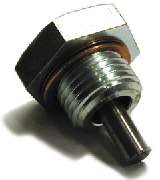The MGA With An Attitude
RUNNING-IN A Rebuilt Twin Cam - TC-330
On 2/7/2012, Neil Burnside wrote:
"Would anyone have some advice on running in a rebuilt engine? How long should I bench run it before using it on the road? What would people recommend, tick over rev ranges etc"?
Aside from what it may say on page 17 in the Driver's Handbook about how to drive it during the casual break-in period, this question is as much about what was done before the car left the factory (and would we do the same things today?).

I have never owned a Twin Cam, but I will venture an opinion. My first recommendation is a magnetic oil drain plug for the life of the engine but most importantly for the initial break-in period as the cylinder walls and piston rings are wearing smooth together. You might be surprised at how much fuzzy iron whiskers you find on the magnet (which may encourage you to change the oil and filter after 500 miles).
For the most part, treat the initial run-in similar to a pushrod engine. Crank it over with no spark plugs until you see oil pressure on the gauge, then install the plugs and fire it up. Run it 2500 rpm for 20 minutes to bed in the cams and tappets. This is with the car stationary, no working load on the engine. If you need to shut it down during this period, switch off, do whatever maintenance is needed, then resume running 2500 rpm for the balance of the intended 20 minutes.
After this initial cam run-in, check/adjust timing chain tension as needed. I would also check tappet clearances, just to be sure all was well, not expecting anything to be changed from initial setting. Check ignition timing with a strobe light at elevated engine speed to assure the mechanical advance is working, and to assure correct maximum advance at speed. How fast to run it for high speed timing check depends on what distributor advance curve you use. The idea is to run it fast enough to max out the spark advance to assure that you know it is set to correct timing with maximum mechanical advance. Also reset idles speed, check/adjust fuel mixture as may be needed, and check all fluid levels.
If you feel the need to check and/or re-torque the cylinder head (and I would), I think you need to let it cool off before hitting the alloy cylinder head with the torque wrench. For myself, I would re-torque it (cold) after the initial cam run-in and again (cold) after 500 miles (whether it needs it or not, no harm in doing it for self assurance).
Like any other engine, you may expect it to be a little stiff on initial start up, mostly due to friction between piston rings and freshly honed cylinder walls. You might notice a bit of increase of engine speed during the first 20 minute cam run-in as the cylinder walls smooth out a bit. You will be resetting normal idle speed immediately after anyway.
Drive the car in a "moderate fashion" for a while. The Driver's Handbook says not to exceed 45-mph for the first 500 miles, no full throttle operation, no lugging the engine at slow speeds or on hills, and in no case ever exceed 7000 rpm. In that case, don't even let me drive a Twin Cam with a new engine, because I would (probably) never have the patience to drive that casually for that many hours. The engine may seem a bit stiff or resistant to high revving initially. It will most likely loosen up noticeably as you drive, such that you may need to set the idle speed back once or twice during the first 500 miles. Then I would change the oil and filter, resume normal routine maintenance, and drive it like you stole it.
To which Bill Spohn responded:
"Yeah, you got it right. Good prescription for a long lasting engine. The race engines we break in for maybe 30 minutes and then have at it. As far as rev limit, I'd recommend fitting an electronic (or old Lucas special rotor) limiter. They just rev too damned easy"!
|